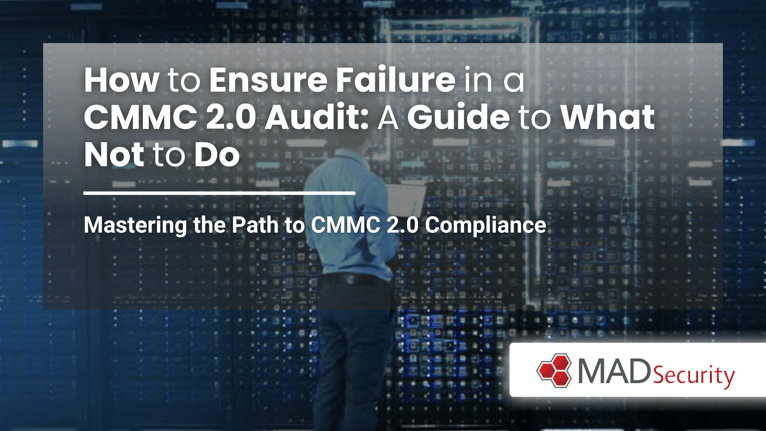
Cybersecurity is paramount in today’s digital world, especially for those in the Defense Industrial Base (DIB) dealing with Federal Contract Information (FCI) or Controlled Unclassified Information (CUI). The Cybersecurity Maturity Model Certification (CMMC) 2.0 audit is a vital process that helps the Department of Defense (DoD) ensure that DIB companies meet necessary cybersecurity standards.

However, as MAD Security, an industry-leading cybersecurity MSSP, we often see common pitfalls that could lead to an audit failure.
While our goal is to guide companies to pass their CMMC audits successfully, understanding what guarantees failure can be just as crucial.
The Top 10 NO-NOs for CMMC 2.0 Audit Success
1. Inaction: Doing nothing at all is a surefire way to fail. Ignoring the CMMC requirements might seem like an option, but it is essentially an open invitation to cyber threats and a guaranteed audit failure.
2. Procrastination and Neglect: Delaying or ignoring the implementation of the necessary security controls and processes leaves your systems and data vulnerable, signaling to auditors that your company does not prioritize cybersecurity.
3. Poor Credential Management: Using weak, default passwords, sharing credentials, or allowing unauthorized access demonstrates a fundamental lack of security hygiene.
4. Lack of Documentation: Security policies and procedures must be documented and updated regularly. Failure to do so means there’s no evidence of compliance or a structured approach to cybersecurity.
5. Ignoring Security Alerts: Not monitoring or reporting suspicious activities and ignoring or disabling security alerts or warnings shows a blatant disregard for security protocols and can be interpreted as an attempt to conceal issues.
6. Covering Up Incidents: Concealing or falsifying cyber incidents or breaches is unethical and compounds vulnerabilities, making your organization a liability rather than a trusted partner.
7. Using Outdated Technology: Employing outdated or unsupported software, hardware, or firmware introduces unnecessary risk and points to a lack of commitment to maintaining a secure environment.
8. Foregoing Security Tools: Omitting the implementation or maintenance of security tools, such as antivirus programs, firewalls, and encryption, is akin to leaving your digital doors wide open.
9. Neglecting Data Backups: Irregular data backups, or storing them insecurely, is a recipe for disaster. This practice can lead to irretrievable data loss in the event of a cyber incident.
10. Disregarding Expert Guidance: Refusing to seek or accept guidance from a CMMC Registered Provider Organization (RPO) is equivalent to navigating uncharted waters without a map. It shows a lack of due diligence and collaboration.
Turning Failures into Success

At MAD Security, we believe in learning from mistakes. The aforementioned practices are exactly what we help companies avoid. Our ‘Completely MAD Security Process’ ensures that you avoid these pitfalls and excel in your cybersecurity practices.
From conducting deep dive discoveries to designing solutions that align with your needs, we ensure that your company embodies the cybersecurity standards expected by the DoD.
The Path to CMMC Compliance
A successful CMMC audit stems from a robust cybersecurity strategy that includes:
- Active Engagement: Be proactive in your cybersecurity efforts. Understand the CMMC requirements and actively work towards meeting them.
- Continuous Improvement: Always strive for excellence. Implement a continuous improvement process and never settle for “good enough” in cybersecurity.
- Strong Security Practices: Implement strong, unique passwords, manage credentials securely, and ensure proper access control.
- Comprehensive Documentation: Maintain a detailed log of security policies and procedures and ensure they are updated and reviewed regularly.
- Vigilant Monitoring: Actively monitor your systems for suspicious activities and promptly address security alerts.
- Transparency: Be transparent about cyber incidents and collaborate with authorities to resolve them.
- Modern Technology: Use up-to-date and supported technology to reduce vulnerabilities and compatibility issues.
- Invest in Security Tools: Deploy and maintain essential security tools to protect against and respond to cyber threats.
- Regular Data Backups: Backup your data regularly and securely to prevent loss and enable quick recovery.
- Expert Collaboration: Work closely with an RPO to ensure compliance and enhance your cybersecurity posture.
Conclusion: Failing a CMMC 2.0 audit is avoidable
By understanding and acting on the requirements, maintaining rigorous cybersecurity practices, and engaging with experienced cybersecurity partners like MAD Security, your organization can achieve compliance and a level of security that protects your operations and the sensitive information you handle. Remember, the goal is not just to pass an audit but to ensure your business’s enduring security and trustworthiness in the defense supply chain.
Original Published Date: February 21, 2024
By: MAD Security

